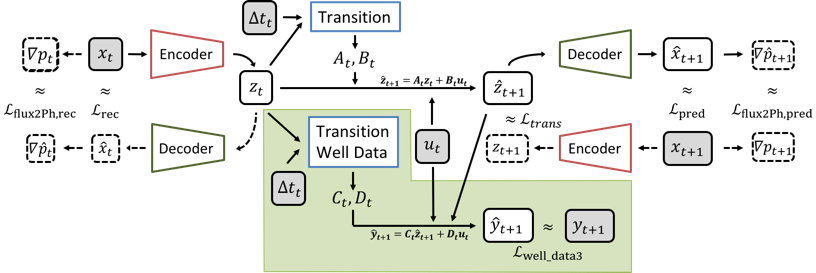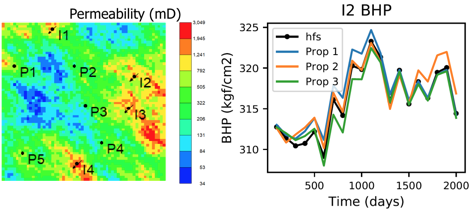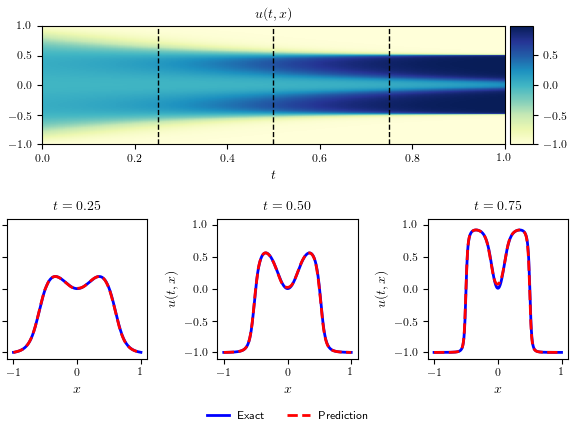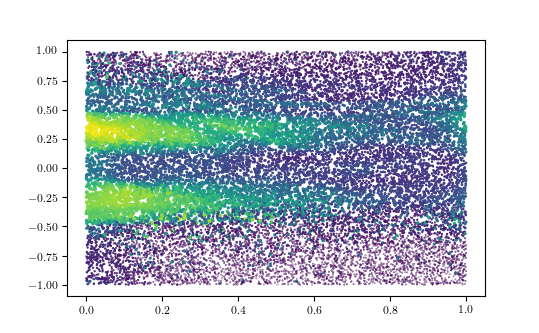Project 1 – Reservoir Simulation
Eduardo Gildin, Ulisses Braga-Neto, Yalchin Efendiev
The objective of this project is to develop novel machine learning architectures for fast and robust reservoir simulation. Machine learning is driving a paradigm shift in several reservoir simulation domains by rapidly expanding the frontiers of research in embedding physics into data driven models and /or extracting physical insights from data. These transformations aim to create fast models with long term predictive capacity, improve the simulator engine, enable models to be more interpretable and generalizable, and help in discovery of unexposed reservoir dynamics [Jin and Durlofsky, 2020]. Fig. 3 depicts a new deep learning architecture design to reduce the computation efforts in reservoir simulation. This project explores new approaches to physics-based and data-driven models and combinations thereof that effectively embeds physical constraints, conservation laws and constitutive relations with data for robust upscaling, sensible time-stepping, accurate proxy models and efficient optimization schemes [Cheung et al, 2020]. Figure 4 depicts the fast solution obtained by a physics-aware ML framework [Coutinho et al 2021]. Here, the solution of the high fidelity simulation (black line) is matched using the approximated solution (green line) Petroleum and natural gas will continue to contribute to global energy demands while several technological advances proposed recently will reduce their impact on the environment aiming at the ambitious zero-net carbon production. Unconventional (e.g., shale) production along with hydraulic fracturing processes require the combination of multi-scale and multi-physics phenomena that are computationally expensive to solve [Florez and Gildin, 2019]. The underlying partial differential equations involve coupling reservoir simulation with geomechanical models and very often some kind of model reduction approach is used to mitigate the computational cost . This project will also address this issue by investigating local-global model reduction strategies in a machine learning (deep learning) context. We will consider tailored loss functions (i.e., mass conservative, flux conservations, conservation of geomechanical features, among others) to develop novel deep learning architectures that can benefit from local multiscale computations.


Project 2 – Thermonuclear Supernovae: A Deep Neural Network Approach to the Explosion Physics
Lifan Wang, Jian Tao, Lisa Perez
We study Type Ia supernovae (SN~Ia) because they are magnificent stellar fireworks. They enable studies of stars and galaxies and measurements of precise distances to far away galaxies. With the anticipated launch of the James Webb Space Telescope (JWST), SN~Ia will be observable out to near the epoch of the first stars. JWST may thus allow for the construction of the expansion history of the Universe out to a redshift above 5. As the SN expands and thins out, the interior of the ejecta is progressively revealed. The luminosity at optical maximum has a strong correlation with the shape of optical light curves. Unlike stellar spectroscopy, where atomic lines can usually be resolved through high resolution spectroscopy, spectral lines of SNIa are heavily blended owing to the high expansion velocity of the ejecta. This means the forward problem of going from models directly to observations is very difficult. We propose to address the inverse problem by which the physical conditions of the explosion are derived from the observational data (Fig below). This is only possible now with the tremendous development in machine learning in recent years. The aim of this proposal is threefold. First, we will construct data-driven models of the observational data. Second, we will assemble an Artificial Intelligence Assisted Inversion (AIAI) algorithm for theoretical radiative transfer models to retrieve the initial model parameters based on the model outputs. Thirdly, we will combine observations and the AIAI to explore intrinsic properties of SN~Ia and establish a new link between the two. The proposed studies will lead to a new approach to supernova cosmology that can quantitatively incorporate the latest in observational and theoretical developments.

Project 3 – Microstructure Informatics
Raymundo Arroyave, Ulisses Braga-Neto, Levi McClenny, Vahid Attari
The goal of this project is to develop novel scientific machine learning (SciML) algorithms and to apply them to highly coupled multi-physics thermodynamically consistent phase field models for microstructure evolution, in order to deliver a set of efficient and accurate physics-aware forward and inverse models of processing-microstructure relationships in nanostructured composite thermoelectric materials, together with reliable uncertainty quantification metrics to support decision making in the design of these materials. Figure 1 shows that the self-adaptive PINN can solve the Allen-Cahn equation, commonly used in phase field models, with a high degree of accuracy. The self-adaptive PINN is a novel paradigm introduced by our group, where the neural network learns autonomously to focus on the important regions of the solution domain, by means of fully-trainable adaptation weights that force the algorithm to focus on the difficult or stubborn regions of the solution. Figure 2 displays the “attention mask” of self-adaptive weights learned by the neural network in the solution of the previous problem. We can see that the neural network spends more effort early (on the left of the plot). This is in agreement with the fact that the Allen-Cahn is a reaction-diffusion PDE, for which an inaccurate approximation early in the evolution precludes a good solution over the entire time interval.

